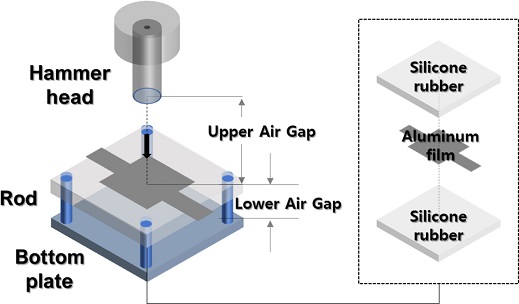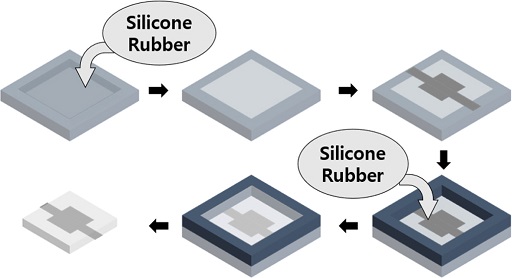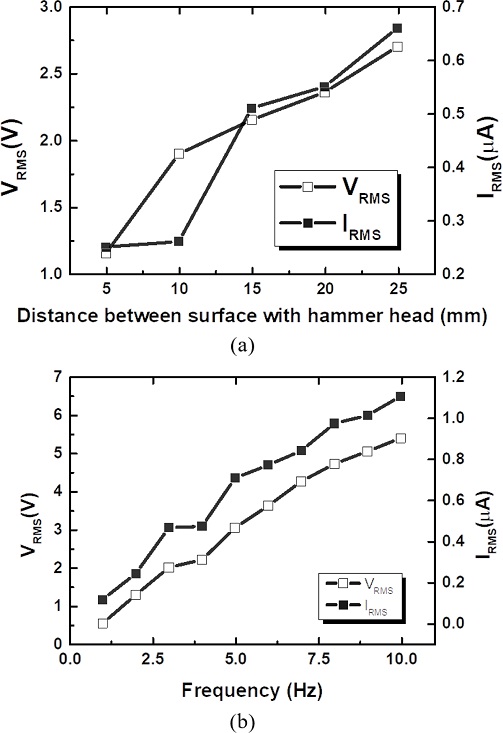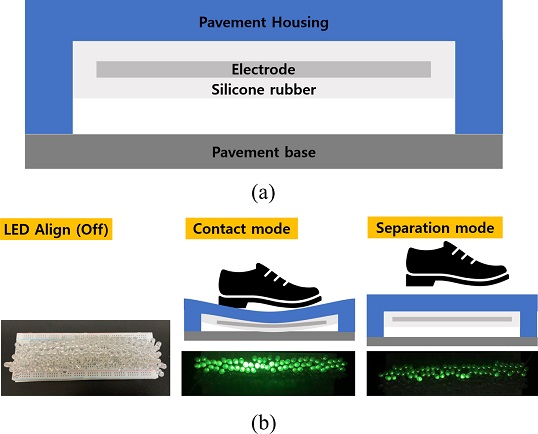
에너지 하베스팅 성능 향상을 위한 이중 접촉 마찰대전 발전기 개발 및 특성 분석
 ; Jinhyoung Park3, #
; Jinhyoung Park3, #
Copyright © The Korean Society for Precision Engineering
This is an Open-Access article distributed under the terms of the Creative Commons Attribution Non-Commercial License (http://creativecommons.org/licenses/by-nc/3.0) which permits unrestricted non-commercial use, distribution, and reproduction in any medium, provided the original work is properly cited.
Abstract
A major goal of triboelectric generator is to improve its power output by identifying and optimizing the factors contributing to the harvesting capability. In this study, we developed a double-contact triboelectric nanogenerator (DC-TENG) capable of two contact and separation pairs by adding an additional air-gap layer. The voltage and current output was characterized as a function of the contact speed, position, stroke time (ST), standstill time (SST), and the existence of two air-gaps. The voltage and current output increased non-linearly with decreasing the times. The DC-TENG produced the maximum voltage and current output when the ratio of ST to SST was 7 to 3. Our prototype resembling a pavement block was capable of lighting 144 LED lights by producing a maximum output of 650 V, 25 μA at a pressure of 0.5 kgf/cm2.
Keywords:
Energy harvesting, Triboelectric nanogenerator, Air-gap layer, Contact behavior키워드:
에너지 하베스팅, 마찰대전 발전기, 공기층, 접촉 거동1. 서론
에너지 하베스팅 기술(Energy Harvesting Technology, EHT)은 우리 주변에 존재하는 잉여에너지들을 수집하여 전기에너지로 변환시키는 저전력 신재생에너지 기술이다. 관련 소자들은 비교적 간단한 제작 과정과 저렴한 재료로 제작할 수 있어, 사물인터넷(Internet of Things, IoT) 기술발전에 의해 증가하는 저전력 IoT 디바이스의 에너지원으로 활용이 예상되고 있다. 특히, 전력망과 연결되지 않은 독립적인 디바이스의 에너지 공급원으로 유망한 차세대 기술로 주목받고 있다.1-5
EHT는 작동원리에 따라 압전 발전기(Piezoelectric Generator), 열전발전기(Thermoelectric Generator), 광발전기, RF 발전기, 및 마찰대전 발전기(Triboelectric Nanogenerator, TENG)로 나누어진다.2-4 마찰대전 발전기는 왕종린 교수 연구팀에서 처음 제안되어, 2012년을 기점으로 활발하게 연구되고 있다. 주요 작동원리는 다른 재료로 이루어진 소자 접촉면의 물리적인 접촉/분리과정 중에 발생하는 분극, 전하 분리 및 전하이동 현상에 착안한 것으로,6-8 접촉면의 미끄러짐, 압축, 굽힘 등 다양한 형태의 상대운동을 활용하여 전기에너지를 얻을 수 있는 장점이 있다.9-12 일반적으로 마찰대전 발전기의 출력은 두 접촉면 사이 전압차, 전하이동량, 접촉면 사이의 거리에 지배를 받게 된다.13-16 이중 접촉면 사이의 거리와 접촉면 사이에 사용된 물질층(예: 공기, 질소, 아르곤 등17-19)은 정전용량(Capacitance) 및 전기력(Electric Field Force)에 영향을 주게 되어 출력 특성을 좌우하게 된다.14-16,20-26 또한 접촉부의 접촉 시간,13,22,24,27 접촉력,20,21,23,27-31 접촉속도,13,23,32 소자 두께 및 계면 형상33-35과 접촉거리나 접촉면의 개수14,15,36-38 등을 설계변수로 하는 다양한 선행 연구가 진행되어 왔다.
최근에는 접촉/분리되는 횟수를 늘려 출력을 향상시키기 위한 연구들이 보고되고 있다. Cui의 연구에서는 접촉면 사이에 다중 간격(Multigap Layer)을 사용하여, 공기간극의 거리와 접촉력에 따른 출력 특성을 평가하였다.31 Chun은 접지부와 마찰대전 발전기의 층 구조를 변화시켜 출력을 증대시켰고,37 Taghavi는 공기층을 추가한 전자기 발전과 마찰대전 발전을 취합한 하이브리드 형태의 발전기에 대해 보고하였다.32 하지만, 이러한 다중 접촉 연구들은 접촉/홀드/분리 스트로크 조건에 따른 출력 특성에 대한 연구가 미비하다.
본 연구에서는 출력을 높이기 위해 접촉과 분리가 이중으로 일어나는 마찰대전 발전기를 개발하였다. 이중 접촉/분리 구조가 출력에 미치는 영향을 분석하고, 타격 빈도와 시간 등에 따른 최적화된 출력을 알아보았다. 또한, 보도블럭 형태의 프로토타입을 만들어 보행 시 전달되는 힘에 의해 다수의 LED (Light-Emitting Diode)를 밝힐 수 있음을 보여, 제시한 발전기의 응용 가능성에 대해 고찰해보았다.
2. 마찰대전 발전기 시편의 제작
이중 접촉 마찰대전 발전기(Double-Contact Triboelectric Nanogenerator, DC-TENG)의 전반적인 구성은 Fig. 1과 같다. DC-TENG의 구조는 4개의 지지대(Rod)로 소자의 각 모서리를 구속하여, 외력에 의해 소자가 변형되더라도 재료의 탄성에 의해 평평하게 회복 가능한 구조로 설계되었다. 에너지 하베스팅을 위한 기계적 에너지 입력은 정밀제어가 가능한 리니어모터(Custom Order, Linmot Co.)를 사용하였고, 모터의 끝단인 헤머 헤드(Hammer Head)와 바닥면(Bottom Plate)이 소자와 접촉 및 분리된다(지름 = 15mm, 1.6 cm2). 헤머헤드와 바닥면 물질은 니트릴(Nitrile)이다. 소자 세부 구성은 실리콘러버(Silicone Rubber)와 알루미늄 필름(Aluminum Film)으로 구성된 평판 형태의 소자이다. 실리콘러버(넓이 = 36 cm2 (60 × 60 mm), 두께 = 4mm)는 소자의 형태를 유지하고, 탄성 회복을 담당하게 된다.39
알루미늄 필름은 전자 이동을 담당하게 되며, 넓이 16 cm2(40 × 40 mm), 두께 30 μm로 소자의 정중앙에 위치시켜 상단과 하단에서 대전이 동일하게 일어날 수 있도록 설계하였다. 이중 접촉/분리를 위해서 공기층은 소자를 중심으로 헤머와 소자 상단 표면 사이에 존재하는 상단 공기층(Upper-Air Gap)과 바닥면과 소자 하단 표면 사이에 존재하는 하단 공기층(Lower-Air Gap), 3개로 구성된다. 출력 측정을 위해 사용된 장비는 오실로스코프(TBS2072, Tektronix Inc.), 고전압프로브(P5100A, Tektronix Inc., 40 MΩ)이며, 전류 측정을 위해 저잡음 전류증폭기(Low-Noise Current Amplifier, DLPCA-200, Femto Inc.)를 사용하였다.
마찰대전 발전기 소자 제작 과정은 Fig. 2에서 확인할 수 있듯, 실리콘러버(Dragon SkinTM 10NV, Smooth-On Inc.)의 주제와 경화제를 1 : 1로 섞은 뒤 시편 크기의 틀에 실리콘러버를 붓고, 오븐에서 40oC로 30분 동안 건조한다. 이후 알루미늄 전극을 소자의 중앙에 위치시키고, 동일한 크기의 틀을 그 위에 정렬하여, 실리콘러버를 추가한 뒤 높이를 맞춘다. 마지막으로 50oC에서 1시간 동안 오븐에서 완전히 건조한 후 몰드에서 이탈시켜 완성한다.
3. 실험 결과 및 고찰
DC-TENG은 접지부와 알루미늄 전극 사이에 전류가 흐르는 단일 전극(Single-Electrode) 구조의 TENG으로,42-44 작동 메커니즘은 접촉대전(Contact-Electrification)과 정전기 효과(Electrostatic Effect)에 기반한다.40,41 구체적인 마찰대전 사이클은 Fig. 3(a)에 묘사하였다. 접촉 마찰대전은 헤머헤드의 니트릴 표면이 소자의 실리콘러버 표면과 접촉할 때 발생하는데, 실리콘러버가 니트릴보다 음전하 친화성이 높기 때문에 니트릴에서 실리콘 러버로 음전하가 이동하게 되어 소자 표면이 대전되게 된다.42-44 이때, 정전기 효과에 의해서 알루미늄 전극은 전하를 유도하고, 유도된 전하에 의해 알루미늄 전극과 접지 사이에 전위차가 발생하여 마찰대전 발전기에 전류가 발생하게 된다.15,23
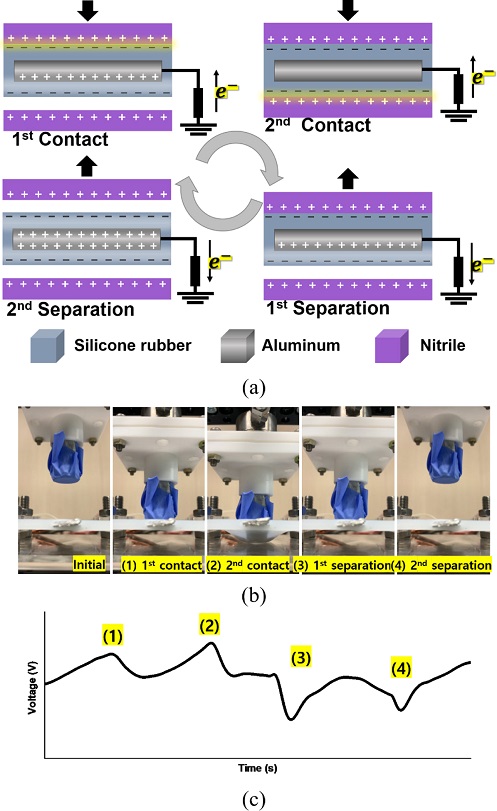
Working principle of the DC-TENG (a) Cyclic mechanism of triboelectrification by DC-TENG and (b) The 5-steps of visual information of contact/separation and example of electrification information by DC-TENG
헤머를 기준으로 표기된 접촉순서는, Fig. 3(b)에서 볼 수 있다. 먼저, 헤머의 원위치(Initial)와 소자 상단 표면 사이에 있는 상단 공기층을 지나 초기 접촉(1st Contact)이 발생한다. 그리고 소자의 하단 표면과 바닥면 사이에 있는 하단 공기층을 통과하여 소자 하단면과 바닥이 닿아 이차 접촉(2nd Contact)이 발생된다. 이후, 헤머가 원위치로 돌아가게 되면서 바닥면과 소자의하단 부분이 분리되는 초기 분리(1st Separation)가 일어나고, 마지막으로 소자의 상단 부분과 헤머가 분리되는 이차 분리(2nd Separation)가 발생하여 행정이 완성된다. 두 번의 접촉과 분리는 앞서 언급된 마찰대전 현상을 일으키는 지배적인 원인이며, 행정에서 발생하는 전기적 출력신호는 Fig. 3(c)와 같은 파형을 가진다.
DC-TENG의 주된 에너지 향상 원인인 이중 접촉(Double-Contact, DC)의 영향을 정량적으로 분석하기 위해 다음과 같은 대조군 시험을 시행하였다. Fig. 4(a)에서 확인할 수 있듯이, DC-TENG을 적용시킨 이중 접촉 방식과 2개의 단일 접촉 방식: 소자 상단 표면과 헤머 표면을 부착시킨(Head Fixed, HF) 방식과 바닥면과 소자를 부착시킨 하부고정(Bottom Fixed, BF)의 출력전압과 전류를 비교하였다. 모든 시험의 접촉 빈도는 5 Hz, 접촉거리는 30mm로 동일한 조건에서 진행하였다. 각 접촉 모드에서 16초 동안 5 Hz로 지속적으로 접촉했을 때 전압 및 전류의 실효값(Root Mean Square, RMS)은 2.15 V, 0.51 μA로 DC Mode에서 가장 높은 출력을 얻을 수 있음을 확인할 수 있다(Figs. 4(b)와 4(c)). 결과를 뒷받침하는 내용으로 16초의 데이터를 초 단위로 확대하여 접촉에 따른 출력 특성을 확인했고, DC Mode에서 가장 높은 출력 곡선이 나타나는 것을 확인하였다. HF와 BF의 경우 비슷한 출력을 보이지만, HF Mode에서 출력이 조금 더 높은 것을 확인할 수 있었다.

Characteristic analysis of Contact mode (a) Schematic illustration of air-gap layer comparison test (b) Voltage comparison (RMS) for each mode (BF, HF, DC) and (c) Current
출력에 영향을 미치는 인자 중에 하나인 타격속도와 빈도에 따른 출력을 분석하였다. Fig. 5(a)와 같이 접촉은 타격 구간(Stroke Time, ST)과 접촉 유지 구간(Standstill Time, SST)으로 구성된다. 과정은 초기 위치(Initial Position)에서 하강하여 헤머가 접촉 길이(Stroke Length)만큼 움직여 소자 하단면이 바닥과 완전히 접촉하게 되고, 접촉이 유지되는 SST 기간을 거친다.
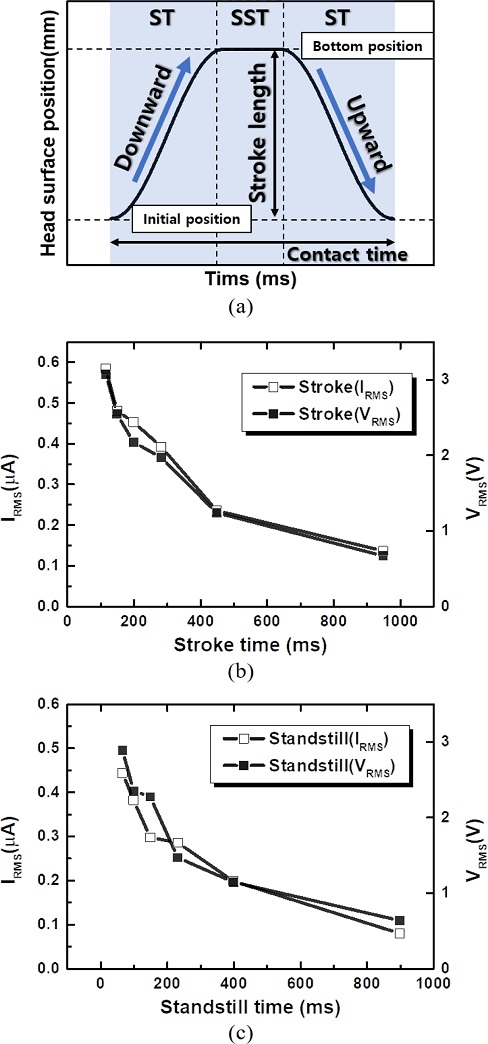
Feature of contact behavior with contact speed (a) Displacement curve of hammer surface position and composition of impact curve (Stroke, Standstill) (b) V&I by Stroke time (ST) variation and (c) Standstill time (SST) variation
이후 원점까지 상승하며 원위치로 복귀하여 접촉이 완료된다. ST 및 SST에서 각 부분이 가지는 출력 특성을 분석하기 위해 먼저, SST을 50ms로 고정한 뒤, ST를 조절하여 여러 접촉 속도에 따른 전압, 전류를 측정했다. 전반적으로 ST가 증가함에 따라 전압과 전류가 감소되었다(Fig. 5(b)). 특히, ST는 300 ms를 기준으로 출력전압과 전류에 급격한 변동이 있는 것을 확인할 수 있다. 그리고, SST에 따른 출력 특성을 분석하기 위해 ST을 50ms로 고정시킨 뒤 SST을 달리하여 측정하였다. SST이 증가함에 따라 출력이 감소하는 것을 확인했으며, 동일하게 300 ms 구간에서 급격한 기울기로 출력전압과 전류가 변하는 것을 확인할 수 있었다(Fig. 5(c)).
동일한 추이를 가진 변수인 SST와 ST 조합의 최적비를 구하기 위해 접촉 시간을 고정하여 접촉 빈도를 5 Hz로 고정시킨 후(접촉 시간: 200 ms), SST을 0에서 50%까지 10% 구간으로 변동을 주어 관찰하였다(Fig. 6(a)). 이에 따른 결과로 Fig. 6(b)와 같이 접촉 빈도 변화에 ST와 SST의 구성에 따라 출력전압과 전류가 달라질 수 있다는 것과 전압과 전류가 비교적 동일한 추이를 나타내는 것을 확인할 수 있다.

Optimization of contact behavior. (a) Contact behavior variable according to the ratio of stroke and standstill with fixed frequency (5 Hz) and (b) Voltage and current by contact behavior
해당 분석을 통해 총 접촉 시간에서 SST이 30% 비를 가질 때 가장 높은 출력을 얻을 수 있다. 최적 출력을 끌어내는 ST : SST = 7 : 3 비율을 기준으로 DC-TENG의 접촉 빈도(Frequency)와 공기층 두께에 따른 출력 특성을 분석하였다. Fig. 7(a)는 상부 공기층 두께에 따른 출력 특성을 관찰하였다. 실험 모델은 접촉 빈도를 5 Hz로 고정시킨 뒤, 5에서 25mm까지 5 mm 구간으로 증대하였다. 결과로, 길이가 늘어날수록 출력전압과 전류도 늘어나게 되었다. Fig. 7(b)를 보면, 접촉 빈도를 1에서 7Hz까지 증가함에 따라 출력전압과 전류가 증가함을 확인하였다. 위 실험에서 헤머의 ST, SST 및 타격속도 변화에 따른 출력 관찰을 통해 속도의 크기와 출력이 비례관계라는 것을 확인하였다. 이와 같은 현상은 마찰대전의 Short Circuit Current (ISC) 이론식 식(1)을 바탕으로 설명된다.16 해당 식은 소자의 넓이 S, 전하밀도 σ, 유효두께상수인 d0, 시간에 따른 속도 및 유전체간 거리 x로 구성된다. 식(1)을 통해 알 수 있는 것은 속도와 단락 전류의 크기가 비례관계를 형성하기 때문에, 속도의 크기가 변함에 따라 전류 출력의 변화를 가진다.
| (1) |
마찰대전 발전기의 출력을 효과적으로 활용하기 위해서는 해당 발전소자와 회로에 부가되는 외부 저항의 크기에 따른 최적 출력값을 확인하는 과정이 필요하다. 외부 가변저항을 추가하여 1 M-1 GΩ 범위에서 DC-TENG의 전압 및 전류 변화를 관찰하였다(Fig. 8(a)). 5 Hz 속도, ST : SST = 7 : 3의 스트로크 시간 비율 조건에서 DC-TENG의 타격 실험을 진행하였다. Fig. 8(b)와 같이 10MΩ의 외부 부하 저항 조건에서 1.14 μW의 최대 실효 출력을 확인하였다.
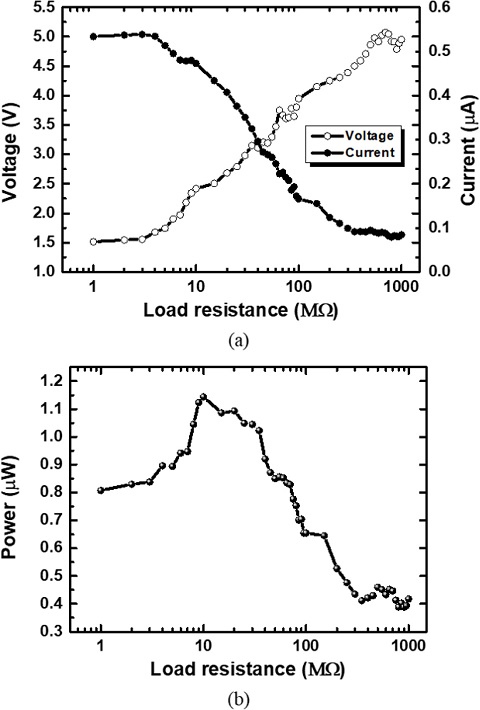
Influence of the load resistance on the DC-TENG (a) Voltage (RMS), Current (RMS) and (b) Power (RMS)
본 연구를 통해 제안된 DC-TENG 구조는 반복적인 압축 하중에 의해 구동하기 적합한 발전기 장치이다. 이에 주변 기계적 에너지 중 하중을 쉽게 받을 수 있는 보도블럭 구조를 모사하여 보도블럭 타입의 DC-TENG을 제작하였다(Fig. 9(a)). 해당 장치는 DC-TENG과 동일하게 대전체로 실리콘러버를 전극으로 알루미늄 필름을 구성하였다. 활용면적은 400 cm2 (200 × 200 mm)으로, 외력 제거 이후에 탄성 복귀가 가능하도록 다공성 구조의 폴리에틸렌을 하우징으로 사용하였다. 장치를 구동하기 위해 2 Hz 접촉 빈도, 0.5 kgf/cm2의 압력을 가했다. 이를 통해 650 V, 25 μA의 Peak 출력을 얻을 수 있었고, 144개의 LED들을 직렬로 연결하여 밝힐 수 있었다(Fig. 9(b)). 이는 기본 사이즈의 DC-TENG의 Peak 출력값인 35V, 1.5 μA의 대략 20배에 해당하는 값으로, 사이즈 면적 증가에 따른 비례 정도로 출력이 증가한 것을 확인할 수 있다. 해당 LED는 다이오드 극성을 반대로 결합하여, 접촉 시 72개의 양극 배열의 LED가 먼저 밝혀지고, 분리 시 음극배열의 나머지 LED가 교차로 밝혀지도록 구성하였다. 이와 같은 결과로 DC-TENG을 적용한 자가발전 장치는 야간 보행 중, 어두운 골목길이나 등산로 등을 밝히는 용도로 활용이 가능하다. 또한 보도블럭 장치에서 나오는 출력신호를 분석하여, 도심 지역에서 인도를 지나가는 유동인구를 분석하는 스마트 디바이스로도 활용할 수 있어, 그 활용 가치가 매우 넓다고 할 수 있다.
4. 결론
본 논문에서는 이중 접촉 마찰대전 발전기를 개발하여 단일 접촉의 일반적인 마찰대전 발전기보다 높은 출력을 낼 수 있음을 확인하였다. 또한, 접촉 거동을 구성하는 각 행정의 시간(ST, SST)에 따라, 출력이 달라질 수 있음을 알 수 있었다. 동일한 접촉 빈도(5 Hz) 조건에서 ST와 SST의 비율을 달리하여, ST : SST = 7 : 3 비율에서 가장 높은 출력을 얻어낼 수 있음을 확인하였다. 또한, 소자의 크기를 키워 보도블럭용 이중 접촉 마찰대전 발전기를 제작하였고, 접촉당 144개의 LED를 밝힐 수 있음을 확인하여 제안하는 발전기의 응용 가능성에 대해 타진하였다.
Acknowledgments
이 논문은 2020년도 한국기술교육대학교 신임교수 연구과제 지원에 의하여 연구되었으며, 정부(교육부)의 재원으로 한국연구재단의 지원을 받아 수행된 기초연구사업임(No. NRF-2018R1D1A1B07040446).
REFERENCES
-
Mitcheson, P. D., Yeatman, E. M., Rao, G. K., Holmes, A. S., and Green, T. C., “Energy Harvesting from Human and Machine Motion for Wireless Electronic Devices,” Proceedings of the IEEE, Vol. 96, No. 9, pp. 1457-1486, 2008.
[https://doi.org/10.1109/JPROC.2008.927494]

-
Ku, M. L., Li, W., Chen, Y., and Liu, K. R., “Advances in Energy Harvesting Communications: Past, Present, and Future Challenges,” IEEE Communications Surveys & Tutorials, Vol. 18, No. 2, pp. 1384-1412, 2015.
[https://doi.org/10.1109/COMST.2015.2497324]

-
Zou, H. X., Zhao, L. C., Gao, Q. H., Zuo, L., Liu, F. R., et al., “Mechanical Modulations for Enhancing Energy Harvesting: Principles, Methods and Applications,” Applied Energy, Vol. 255, Paper No. 113871, 2019.
[https://doi.org/10.1016/j.apenergy.2019.113871]

-
Pu, X., Hu, W., and Wang, Z. L., “Toward Wearable Self-Charging Power Systems: The Integration of Energy-Harvesting and Storage Devices,” Small, Vol. 14, No. 1, Paper No. 1702817, 2018.
[https://doi.org/10.1002/smll.201702817]

-
Akan, O. B., Cetinkaya, O., Koca, C., and Ozger, M., “Internet of Hybrid Energy Harvesting Things,” IEEE Internet of Things Journal, Vol. 5, No. 2, pp. 736-746, 2017.
[https://doi.org/10.1109/JIOT.2017.2742663]

-
Kim, W., Bhatia, D., Jeong, S., and Choi, D., “Mechanical Energy Conversion Systems for Triboelectric Nanogenerators: Kinematic and Vibrational Designs,” Nano Energy, Vol. 56, pp. 307-321, 2019.
[https://doi.org/10.1016/j.nanoen.2018.11.056]

-
Wang, Z. L., Chen, J., and Lin, L., “Progress in Triboelectric Nanogenerators as a New Energy Technology and Self-Powered Sensors,” Energy & Environmental Science, Vol. 8, No. 8, pp. 2250-2282, 2015.
[https://doi.org/10.1039/C5EE01532D]

-
Wu, C., Wang, A. C., Ding, W., Guo, H., and Wang, Z. L., “Triboelectric Nanogenerator: A Foundation of the Energy for the New Era,” Advanced Energy Materials, Vol. 9, No. 1, Paper No. 1802906, 2019.
[https://doi.org/10.1002/aenm.201802906]

-
Pan, S. and Zhang, Z., “Fundamental Theories and Basic Principles of Triboelectric Effect: A Review,” Friction, Vol. 7, No. 1, pp. 2-17, 2019.
[https://doi.org/10.1007/s40544-018-0217-7]

-
Wu, J ., W ang, X ., L i, H ., W ang, F ., Yang, W ., e t al., “ Insights into the Mechanism of Metal-Polymer Contact Electrification for Triboelectric Nanogenerator via First-Principles Investigations,” Nano Energy, Vol. 48, pp. 607-616, 2018.
[https://doi.org/10.1016/j.nanoen.2018.04.025]

-
Willatzen, M. and Wang, Z. L., “Theory of Contact Electrification: Optical Transitions in Two-Level Systems,” Nano Energy, Vol. 52, pp. 517-523, 2018.
[https://doi.org/10.1016/j.nanoen.2018.08.015]

-
Matsusaka, S., Maruyama, H., Matsuyama, T., and Ghadiri, M., “Triboelectric Charging of Powders: A Review,” Chemical Engineering Science, Vol. 65, No. 22, pp. 5781-5807, 2010.
[https://doi.org/10.1016/j.ces.2010.07.005]

-
Zhang, H., Quan, L., Chen, J., Xu, C., Zhang, C., et al., “A General Optimization Approach for Contact-Separation Triboelectric Nanogenerator,” Nano Energy, Vol. 56, pp. 700-707, 2019.
[https://doi.org/10.1016/j.nanoen.2018.11.062]

-
Peng, J., Kang, S. D., and Snyder, G. J., “Optimization Principles and the Figure of Merit for Triboelectric Generators,” Science Advances, Vol. 3, No. 12, Paper No. eaap8576, 2017.
[https://doi.org/10.1126/sciadv.aap8576]

-
Niu, S., Liu, Y., Wang, S., Lin, L., Zhou, Y. S., et al., “Theoretical Investigation and Structural Optimization of Single-Electrode Triboelectric Nanogenerators,” Advanced Functional Materials, Vol. 24, No. 22, pp. 3332-3340, 2014.
[https://doi.org/10.1002/adfm.201303799]

-
Niu, S., Wang, S., Lin, L., Liu, Y., Zhou, Y. S., et al., “Theoretical Study of Contact-Mode Triboelectric Nanogenerators as an Effective Power Source,” Energy & Environmental Science, Vol. 6, No. 12, pp. 3576-3583, 2013.
[https://doi.org/10.1039/c3ee42571a]

-
Seol, M. L., Han, J. W., Moon, D. I., and Meyyappan, M., “Triboelectric Nanogenerator for Mars Environment,” Nano Energy, Vol. 39, pp. 238-244, 2017.
[https://doi.org/10.1016/j.nanoen.2017.07.004]

-
Lv, S., Yu, B., Huang, T., Yu, H., Wang, H., et al., “Gas-Enhanced Triboelectric Nanogenerator based on Fully-Enclosed Structure for Energy Harvesting and Sensing,” Nano Energy, Vol. 55, pp. 463-469, 2019.
[https://doi.org/10.1016/j.nanoen.2018.11.022]

-
Zhao, K., Gu, G., Zhang, Y., Zhang, B., Yang, F., et al., “The Self-Powered CO2 Gas Sensor based on Gas Discharge Induced by Triboelectric Nanogenerator,” Nano Energy, Vol. 53, pp. 898-905, 2018.
[https://doi.org/10.1016/j.nanoen.2018.09.057]

-
Seol, M. L., Han, J. W., Moon, D. I., and Meyyappan, M., “Hysteretic Behavior of Contact Force Response in Triboelectric Nanogenerator,” Nano Energy, Vol. 32, pp. 408-413, 2017.
[https://doi.org/10.1016/j.nanoen.2016.12.055]

-
Jin, C., Kia, D. S., Jones, M., and Towfighian, S., “On the Contact Behavior of Micro-/Nano-Structured Interface Used in Vertical-Contact-Mode Triboelectric Nanogenerators,” Nano Energy, Vol. 27, pp. 68-77, 2016.
[https://doi.org/10.1016/j.nanoen.2016.06.049]

-
Zhang, H., Zhang, C., Zhang, J., Quan, L., Huang, H., et al., “A Theoretical Approach for Optimizing Sliding-Mode Triboelectric Nanogenerator based on Multi-Parameter Analysis,” Nano Energy, Vol. 61, pp. 442-453, 2019.
[https://doi.org/10.1016/j.nanoen.2019.04.057]

-
Zhang, Y., Yang, Z., Song, K., Pang, X., and Shangguan, B., “Triboelectric Behaviors of Materials under High Speeds and Large Currents,” Friction, Vol. 1, No. 3, pp. 259-270, 2013.
[https://doi.org/10.1007/s40544-013-0024-0]

-
Hinchet, R., Ghaffarinejad, A., Lu, Y., Hasani, J. Y., Kim, S. W., et al., “Understanding and Modeling of Triboelectric-Electret Nanogenerator,” Nano Energy, Vol. 47, pp. 401-409, 2018.
[https://doi.org/10.1016/j.nanoen.2018.02.030]

-
Wang, S., Niu, S., Yang, J., Lin, L., and Wang, Z. L., “Quantitative Measurements of Vibration Amplitude Using a Contact-Mode Freestanding Triboelectric Nanogenerator,” ACS Nano, Vol. 8, No. 12, pp. 12004-12013, 2014.
[https://doi.org/10.1021/nn5054365]

-
Shi, Q., Qiu, C., He, T., Wu, F., Zhu, M., et al., “Triboelectric Single-Electrode-Output Control Interface Using Patterned Grid Electrode,” Nano Energy, Vol. 60, pp. 545-556, 2019.
[https://doi.org/10.1016/j.nanoen.2019.03.090]

-
Pan, S., Yin, N., and Zhang, Z., “Time- & Load-Dependence of Triboelectric Effect,” Scientific Reports, Vol. 8, No. 1, pp. 1-9, 2018.
[https://doi.org/10.1038/s41598-018-20937-6]

-
Seol, M. L ., L ee, S. H ., H an, J. W., K im, D., Cho, G. H., et a l., “Impact of Contact Pressure on Output Voltage of Triboelectric Nanogenerator based on Deformation of Interfacial Structures,” Nano Energy, Vol. 17, pp. 63-71, 2015.
[https://doi.org/10.1016/j.nanoen.2015.08.005]

-
Vasandani, P., Mao, Z. H., Jia, W., and Sun, M., “Relationship between Triboelectric Charge and Contact Force for Two Triboelectric Layers,” Journal of Electrostatics, Vol. 90, pp. 147-152, 2017.
[https://doi.org/10.1016/j.elstat.2017.11.001]

-
Šutka, A., Mālnieks, K., Lapčinskis, L., Kaufelde, P., Linarts, A., et al., “The Role of Intermolecular Forces in Contact Electrification on Polymer Surfaces and Triboelectric Nanogenerators,” Energy & Environmental Science, Vol. 12, No. 8, pp. 2417-2421, 2019.
[https://doi.org/10.1039/C9EE01078E]

-
Cui, N., Dai, C., Liu, J., Gu, L., Ge, R., et al., “Increasing the Output Charge Quantity of Triboelectric Nanogenerators via Frequency Multiplication with a Multigap-Structured Friction Layer,” Energy & Environmental Science, Vol. 13, No. 7, pp. 2069-2076, 2020.
[https://doi.org/10.1039/D0EE00922A]

-
Taghavi, M. and Beccai, L., “A Contact-Key Triboelectric Nanogenerator: Theoretical and Experimental Study on Motion Speed Influence,” Nano Energy, Vol. 18, pp. 283-292, 2015.
[https://doi.org/10.1016/j.nanoen.2015.10.019]

-
Cui, N., Gu, L., Lei, Y., Liu, J., Qin, Y., et al., “Dynamic Behavior of the Triboelectric Charges and Structural Optimization of the Friction Layer for a Triboelectric Nanogenerator,” ACS Nano, Vol. 10, No. 6, pp. 6131-6138, 2016.
[https://doi.org/10.1021/acsnano.6b02076]

- Gomes, A., Rodrigues, C., Pereira, A., and Ventura, J., “Influence of Thickness and Contact Area on the Performance of PDMS-Based Triboelectric Nanogenerators,” arXiv Preprint arXiv:1803.10070, , 2018.
-
Wang, A. E., Gil, P. S., Holonga, M., Yavuz, Z., Baytekin, H. T., et al., “Dependence of Triboelectric Charging Behavior on Material Microstructure,” Physical Review Materials, Vol. 1, No. 3, Paper No. 035605, 2017.
[https://doi.org/10.1103/PhysRevMaterials.1.035605]

-
Yin, X., Liu, D., Zhou, L., Li, X., Zhang, C., et al., “Structure and Dimension Effects on the Performance of Layered Triboelectric Nanogenerators in Contact-Separation Mode,” ACS Nano, Vol. 13, No. 1, pp. 698-705, 2018.
[https://doi.org/10.1021/acsnano.8b07935]

-
Chun, J., Ye, B. U., Lee, J. W., Choi, D., Kang, C. Y., et al., “Boosted Output Performance of Triboelectric Nanogenerator via Electric Double Layer Effect,” Nature Communications, Vol. 7, No. 1, pp. 1-9, 2016.
[https://doi.org/10.1038/ncomms12985]

-
Li, S., W ang, J ., P eng, W ., L in, L., Zi, Y., et a l., “Sustainable Energy Source for Wearable Electronics based on Multilayer Elastomeric Triboelectric Nanogenerators,” Advanced Energy Materials, Vol. 7, No. 13, Paper No. 1602832, 2017.
[https://doi.org/10.1002/aenm.201602832]

-
Park, S., Mondal, K., Treadway III, R. M., Kumar, V., Ma, S., et al., “Silicones for Stretchable and Durable Soft Devices: Beyond Sylgard-184,” ACS Applied Materials & Interfaces, Vol. 10, No. 13, pp. 11261-11268, 2018.
[https://doi.org/10.1021/acsami.7b18394]

-
Wang, Z. L., “On the First Principle Theory of Nanogenerators from Maxwell's Equations,” Nano Energy, Vol. 68, Paper No. 104272, 2020.
[https://doi.org/10.1016/j.nanoen.2019.104272]

-
Shao, J., Willatzen, M., and Wang, Z. L., “Theoretical Modeling of Triboelectric Nanogenerators (TENGs),” Journal of Applied Physics, Vol. 128, No. 11, Paper No. 111101, 2020.
[https://doi.org/10.1063/5.0020961]

-
Zou, H., Zhang, Y., Guo, L., Wang, P., He, X., et al., “Quantifying the Triboelectric Series,” Nature Communications, Vol. 10, No. 1, pp. 1-9, 2019.
[https://doi.org/10.1038/s41467-019-09461-x]

-
Diaz, A. and Felix-Navarro, R., “A Semi-Quantitative Tribo-Electric Series for Polymeric Materials: The Influence of Chemical Structure and Properties,” Journal of Electrostatics, Vol. 62, No. 4, pp. 277-290, 2004.
[https://doi.org/10.1016/j.elstat.2004.05.005]

-
Molnar, O., Gerasimov, V., and Kurytnik, I. P., “Triboelectricity and Construction of Power Generators based on It,” PrzeglAd Elektrotechniczny, Vol. 94, No. 1, pp. 167-171, 2018.
[https://doi.org/10.15199/48.2018.01.41]

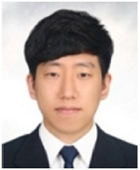
Ph.D. candidate in the Department of Mechanical Engineering, Kyungpook National University. His research interest is functional materials and mechanics.
E-mail: collage@knu.ac.kr

M.S. candidate in the Department of Mechanical Engineering, Kyungpook National University.
E-mail: hahaha88@knu.ac.kr

Ph.D. candidate in the Department of Mechanical Engineering, Kyungpook National University. His research interest is functional materials and mechanics.
E-mail: usman@knu.ac.kr
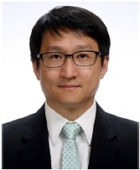
Principal researcher in Korea Institute of Industrial Technology (KITECH). His research interest is semiconductor device fabrication process.
E-mail: hc.cho@kitech.re.kr
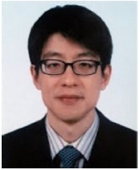
Professor in School of Mechanical Engineering, Kyungpook National University. His research interest is functional materials and mechanics.
E-mail: sykimknu@knu.ac.kr

Professor in School of Mechatronics Engineering, Korea University of Technology and Education. His research interests is high-voltage application of a triboelectric nanogenerator.
E-mail: jhpark98@koreatech.ac.kr
